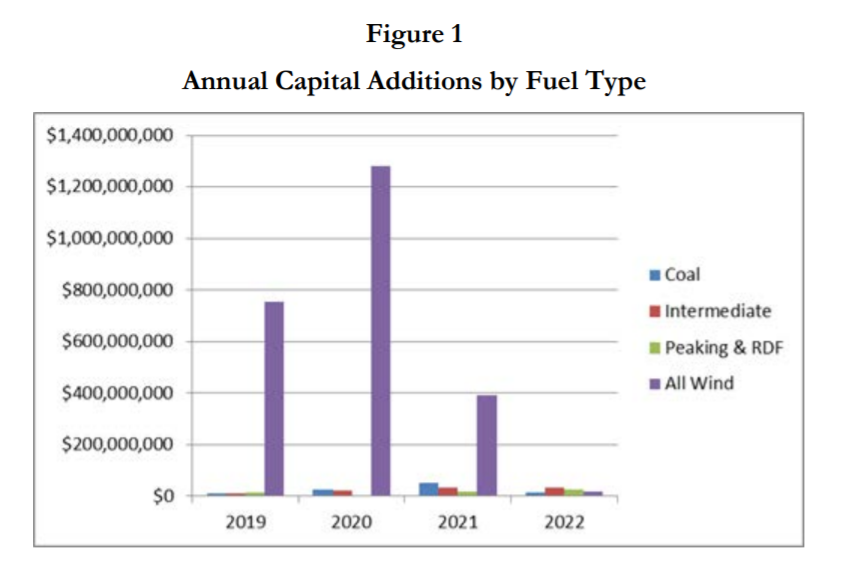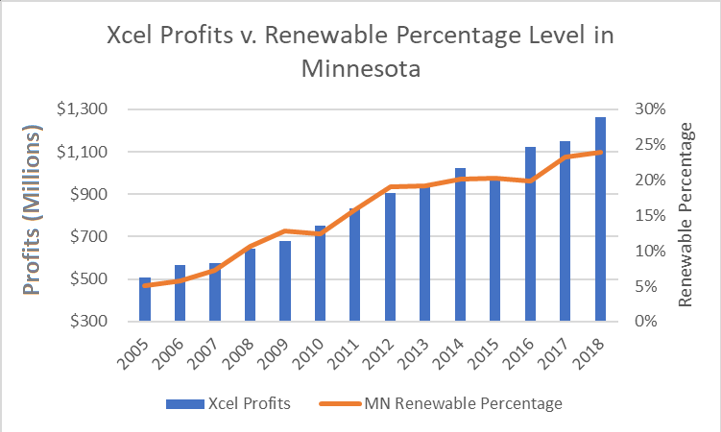Our Perspective: Xcel Quarterly Profits up 35 Percent, Buoyed by Rate Increases
The Star Tribune published a bombshell story last Thursday entitled “Xcel Quarterly Profits up 35 Percent, Buoyed by Rate Increases,” which reported Xcel Energy’s quarterly profits for the last quarter of 2019, but unfortunately, unless people understand energy policy in Minnesota, they would have no idea why this story is so explosive.
According to the Star Tribune article:
“Xcel Energy’s fourth-quarter profits rose 35% and beat Wall Street forecasts, aided by rate increases in several states.”
Higher electric and natural gas profit margins, primarily due to rate increases, added 37 cents per share in 2019, said a report Thursday by Travis Miller, a stock analyst at Morningstar. “We expect similar growth in 2020,” he wrote.
Rate increases tied to Xcel’s capital investments remain the company’s “key earnings driver” this year. Still, “regulatory risk remains high as Xcel seeks rate increases to cover its investments,” Miller wrote.
In order for Minnesotans to fully appreciate this story, they must understand why capital investments are the company’s “key earnings driver,” and what kind of capital investments are driving increases in electricity prices, which in turn are allowing Xcel Energy to reap record profits.
Capital investments automatically increase profits?
In the eyes of private sector companies, capital investments would not be an earning driver, they would be an expense that may, or may not, increase profits to a company by allowing it to produce more goods or provide services over time with lower input costs. The capital expenditures could boost profitability long term, but the fact that the company is spending money would not automatically result in higher profits.
For example, I own a few rental properties, one in Wisconsin and one in Minnesota. If I take money from my savings account to pay for capital improvements such as new flooring, new drywall, or new appliances, my hope is that these investments will increase the desirability to prospective renters and allows me to recoup my investment, plus a profit margin. In other words, because I am a private company operating in a competitive market, my capital investments could increase my profitability, but they are no guarantee that my profits will rise.
However, Xcel Energy isn’t a private company, it is a government-approved monopoly utility that is guaranteed to make a 7.5 percent profit on every dollar they spend on infrastructure, such as wind turbines, solar panels, transmission lines, or even new corporate offices. Xcel also does not operate in a competitive market because Minnesota families and businesses in their service territory are forced to buy their electricity from Xcel, they have no other choice.
As you can imagine, this regulatory framework gives Xcel a very bad incentive to spend as much money as possible, which leads to increasing electricity prices. This is why families and businesses with Xcel Energy as their electricity provider pay far more for their electricity than those served by other utilities in Minnesota, such as Minnesota Power and Otter Tail Power, and this trend has gotten worse over the past 15 years.

What is driving the utility spending that is allowing Xcel to have “Met or exceeded its profit guidance for 15 consecutive years and raised its dividend for the 16th year in a row. And the company’s stock has hit new highs, [Xcel Energy President and CEO, Ben Fowke] said?”
Enormous spending on wind turbines, solar panels, and transmission lines.
Center of the American Experiment’s study “Energy Policy in Minnesota: The High Cost of Failure” detailed how energy companies squandered an estimated $15 billion on wind turbines and transmission lines from 2007 through October of 2017. This figure is now outdated because Xcel has built more wind facilities since this time, and the company plans to spend more than $2 billion more on wind from 2019 to 2021, according to documents submitted to the Minnesota Public Utilities Commission.

Conservatives are generally happy when companies are successful and are able to increase their profits and increase the value of their stock for their shareholders, but when it comes to Xcel we should stop applauding. Xcel is not a private company. Their customers are not allowed to vote with their dollar by choosing another provider if they are unhappy with the cost or service provided to them like they are able to do for most other products or services.
Xcel’s rising profits are driven by crony capitalism and the fact that Xcel spent more money lobbying the legislature than all but three other entities in the state in 2018, according to documents filed with the state. If there are more mandates for wind and solar, Xcel’s profits will soar, but Minnesota families and businesses will suffer as a result of higher electricity prices.

It is the fiduciary responsibility of all companies to maximize profits for their shareholders, and one could argue that Xcel is simply responding to the incentives that are being created by the regulatory environment in which they currently operate. This is true, but it is also a powerful argument to change the way utilities are compensated to blunt their worst financial instincts.
One proposal is to change the rate of return formula to reflect the value that an asset provides to the grid, rather than simply allowing the utility to profit based on the cost of the capital expenditure. Such a reform would more closely align the incentives of Xcel with the desire of consumers to have lower electricity costs.